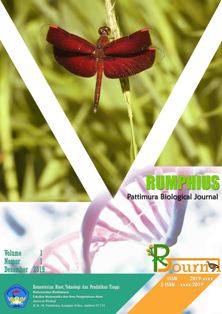ABUNDANCE AND DIVERSITY OF COLLEMBOLA INSECTS IN SWITCHING FIELDS IN WAAI VILLAGE CENTRAL MALUKU
Abstract
Collembola are a good example of the diversity of soil animals and play an important role in nutrient cycling, organic matter decomposition and soil formation which are important parts of forest ecosystems. This research was conducted on cassava land and a vegetable garden in Waai village, Salahutu sub-district, Central Maluku district, on July 18 2020. This study aims to determine the abundance and diversity of the Collembola insect in shifting cultivation in Waai village, Salahutu sub-district, Central Maluku district and its relationship with environmental factors. Results The study obtained 3 families and 6 species with a total abundance of 12.2 individuals/m2. There are differences in the abundance of Collembola found in vegetable gardens and cassava fields. The abundance of Collembola found in the vegetable garden was 3.6 individuals consisting of 2 families and 2 species, while in cassava fields it was 8.6 individuals divided into 2 families and 4 species.
Downloads
References
Amir, A.M. 2008. The role of the springtail insect (Collembola) in order to increase soil fertility. Agency for Agricultural Research and Development. Center for Plantation Research and Development. News 14: 16-17.
Campbell, N.A. & J.B. Reece. 2008. Biology, Eighth Edition Volume 3. Translation: Damaring Tyas Wulandari. Jakarta: Erlangga.
Erniyani K, WahyuniS, Pu'u Y.M.S.W. 2010. Soil mesofauna community structure overhauls organic matter in coffee and cocoa vegetation. Agrica 3: 1-8.
Indriyati., Wibowo, L. 2008. Diversity and Abundance of Collembola and Soil Arthropods in Organic and Conventional Paddy Fields during the Fall season. J. Tropical HPT ISSN 1411-7525. 8 (2)
Michael, P. 1995. Ecological Methods for Field and Laboratory Investigations. Jakarta: University of Indonesia Press.
Monk, A. 2000. Ecology of Nusa Tenggara and Maluku. Pronhallindo Publisher, Jakarta.
Oka, I. D. 2005. Integrated Pest Management and Its Implementation in Indonesia. Gadjah Mada University Press. Yogyakarta.
Purwowidodo. 2003. Practical Guide to Forest Soil Science: Knowing Soil. Faculty of Forestry IPB, Bogor.
Putra, N. S. 1994. Insects Around Us. Kanisius. Yogyakarta. 118 p
Ratnasari. 2015. Arthropod Abundance and Diversity in the Nature Reserve Forest of Pangandaran Regency, West Java. Pasundan University Bandung Thesis: Not Published.
Rosalyn, I. 2007. Insect diversity index in oil palm (ElaeisguineensisJacq.) plantations in the Tanah Raja Perbaungan plantation of PT. Nusantara Plantation III.Thesis. Medan: University of North Sumatra.
Suhardjono R. Y., Deharveng, L., & Bedos, A. 2012. Collembola (pegas tail). Bogor: Vegamedia.
Suin, N. M. 1989. Soil Animal Ecology. Script Earth. Jakarta.
Untung, K. 2006. Introduction to Integrated Pest Management. Yogyakarta: Gadjah Mada University Press.
Authors who propose a manuscript and have it approved for publication know that the manuscript will be registered and become part of the RPBJ. Authors and readers understand that this journal is open and all its contents can be accessed freely, provided that RPBJ is still listed as the source of information. The hope is that this journal can become a vehicle for exchange and scientific knowledge for society and the scientific community, especially in the field of Biology and other branches of science.









